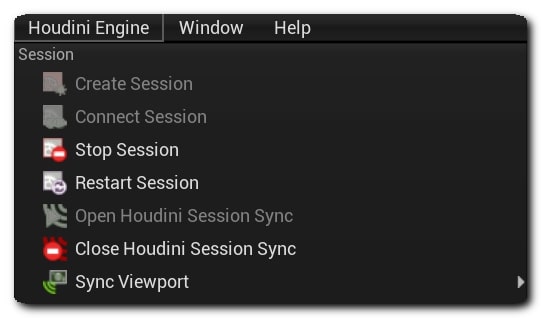| On this page |
The Houdini Engine Session Sync feature allows you to connect to a running instance of Houdini (with UI) instead of a Houdini Engine session (without UI). It supports all the features of regular Houdini Engine workflows but also has additional features specific to SessionSync.
The benefit of SessionSync is that you can view and interact with the Houdini Engine session within Houdini while also working in Unreal. It also synchronizes changes made in either Unreal or Houdini so both programs can make changes and see the same results.
SessionSync enables the following workflows:
-
easy troubleshooting of loaded assets.
-
real-time feedback when building assets in Houdini.
-
changes made in Houdini automatically update in Unreal.
-
better understanding of Houdini Engine’s features and limitations.
Note
Houdini Engine SessionSync replaces the Houdini Engine Debugger that was available in Houdini 18.0 and earlier.
Starting SessionSync ¶
SessionSync must be running in Houdini before the plugin can connect to it. There are 2 ways to connect to SessionSync from the plugin:
-
Launch Houdini with SessionSync from Unreal
-
Connect to a running instance of Houdini with Session Sync
Launch Houdini with SessionSync ¶
From Unreal, you can launch a new instance of Houdini with SessionSync started. The plugin will then automatically connect to it using the current session settings.
To do so, click on Open Houdini Session Sync in the Houdini Engine menu. This will take a few seconds to launch Houdini with SessionSync enabled, and connect to it.

Note
The plugin will automatically stop the current session if the plugin was already using one.
Once connected, you can stop the session at any time from the plugin, and reconnect. You can also stop SessionSync in Houdini and continue to use it as normal. You can also use the Close Houdini Session Sync entry in the Houdini Engine menu to close the session of Houdini running Session Sync.
Connect to Houdini ¶
If Houdini is already running, then the plugin can connect to SessionSync once its enabled. To enable it and connect, follow these steps:
-
In Houdini, open the Houdini Engine SessionSync pane in Windows ▸ Houdini Engine SessionSync.
-
In Connection, select Start to start the Houdini Engine session with SessionSync enabled. The settings such as the TCP Port or Named Pipe, you can leave as default values.

-
In Unreal, you can use the Connect Session in the Houdini Engine menu. If there is a Houdini Engine session already running, stop it using the Stop Session first.
-
Make sure the session settings, available in the Plugin’s settings in Unreal match those used in Houdini.
-
-
Once connected, you can stop SessionSync and reconnect any time. You can also stop SessionSync in Houdini and continue to use it as normal.
Settings ¶
SessionSync behaviour can be changed by the following settings in Houdini:
Setting |
Description |
|---|---|
Sync With Houdini Cook |
Enable this to keep the assets on the plugin side synchronized with cook changes on Houdini side. This allows for changes on either application to be reflected in both directions. |
Cook Using Houdini Time |
Enable this to use the Houdini Timeline time to cook assets. Normally, Houdini Engine uses its own time set via the plugin to cook assets. In SessionSync, the Houdini viewport will cook using the Houdini Timeline time which can make assets out of sync. Enabling this fixes that issue. |
Synchronized Data ¶
SessionSync supports the following data types for synchronization:
-
HDA
-
Inputs
-
Curves
-
Outputs
HDAs, curves, inputs and output nodes function the same way as in non-SessionSync workflow. The difference in SessionSync is that any changes to these assets in Houdini (parameter, node, or network changes) will be reflected across to the plugin automatically.
For HDAs, addition or removal of promoted parameters will not be synchronized unless the HDA is unlocked, resaved and rebuilt in Unreal.